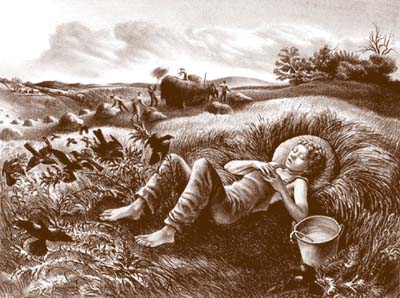
Choreboy
Lithograph, 9" x 12 1/4"
Illinois State Museum collection
This lithograph print shows the hay fields that were once prairie. At the edge of the field, a grove of trees have been preserved, possibly as shelter and habitat for wildlife, and as a windbreak. There is only one farmhouse for miles in this sparsely populated area.
John Stockton de Martelly (1903 - )
John de Martelly was born in Philadelphia, Pennsylvania in 1903. Thomas Hart Benton, the famous regionalist painter was one of his art teachers at the Pennsylvania Academy of Fine Arts. DeMartelly also studied in Florence, Italy and London, England. He became a painter, and by 1937 had won prizes, including the Lighton prize for Best Painting by a Kansas City Artist. He also drew political cartoons and illustrations for a publisher. He was an instructor at the Kansas City Art Institute and later Michigan State University. His drawings, paintings, and prints are in collections of many museums, including the Victoria and Albert Museum, London.
Lithography
The word lithography means stone-writing. In 1798 Aloys Senefelder, a Bavarian playwright, invented this printing system. The artist draws directly on a smooth stone or metal plate with a grease pencil or crayon. After being fixed with a chemical and rinsed with water, the plate is inked. The ink sticks only to the greasy areas. The paper is printed by hand or through a press.